LEH LADAKH PLACES OF INTEREST
Ladakh is Gifted with high mountain, valleys, lakes beautiful ancient Buddhist monasteries on hill top and their resident (monks) chanting prayers, absolutely different culture, courtesy and the smiling faces of the Ladakhis is like an icing on the cake - adding further to its breathtaking landscapes. The charm of its landscape and people will force you to come here again and again
Pangong Tso:
Pangong Tso: (14,270 ft), 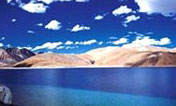 through Changla Pass 17,350 ft., it is the third highest motorable road in the world. It is the highest salt water Lake in the World, shared by two countries India & China. Enjoy the beauty of the lake on the Banks of pangong while appreciating the changing Colors and fascinating high altitude of the Lake.
through Changla Pass 17,350 ft., it is the third highest motorable road in the world. It is the highest salt water Lake in the World, shared by two countries India & China. Enjoy the beauty of the lake on the Banks of pangong while appreciating the changing Colors and fascinating high altitude of the Lake.
Khardung La:
A high mountain pass, 49 km from Leh, the highest motorable road in the world at an altitude of 5379m. it is not very often that one gets to drive on a road at an altitude of 18,380 feet. That is where Khardungla Pass, meaning the ‘Pass of Lower Castle,’ is located on the way from Leh to the Nubra Valley in Ladakh. It is the highest motorable road in the world.
Nubra Valley:s
There is a lot to do in this tranquil valley of flowers. Just going there and experiencing the sights and roughing it out in insulated tents, is an experience in itself. The nip in the air, the white sands, the snow caps, the green tumbling villages, the murmuring rivers, families of yaks and camels, the apricot orchards and the traditional Ladakhi meals served by a bonfire under the moonlight blend flawlessly to give you the most overwhelming experience you can imagine.
Diskit: Diskit is a busy little town, the administrative center of Nubra Valley that is located at the foot of a white-sand desert on the Shyok side of the valley.enjoy that dizzy feeling when you see miles of white sands, and the cold feel of the sand. Don’t miss spotting the two humped Bactrian camels languidly trudging through the desert.
Hundar: Another village on the Shyok side of the valley, Hundar is historically important as it was once the capital of the Nubra Kingdom in the 17th Century. It provides a sudden change from the desert landscape of Diskit with its lush orchards of Apple, Peach and Apricots. It is one of
those rare places where you can see all the elements of nature – snow, desert, greenery and water and in an eye view.
Panamik: The hot springs on the outskirts of Panamik are a sizzling experience, not to be missed.
Thiksey Monastery
Built some 600 years ago, Thiksey monastery consists of 12 levels ascending a hillside, culminating in an incarnate lama’s private abode at the summit. The Gonpa contains 10 temples, below the monastery itself is chapels and houses of monks stretching down the hillside. There are about 100 monks of the yellow-hat sect of Buddhism. 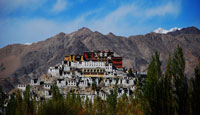 After entering the main courtyard to the immediate right and up several steps is a new temple containing a large Buddha statue.The H.H. Dalai Lama constructed this Buddha, 15 meters tall, in 1980 to commemorate a visit to Thiksey.The statue was made under the guidance,supervision and direction of Kushok Nawang Chamba Stanzin, the present head Lama of Thiksey monastery. The statue is the largest Buddha figure in Ladakh which took four years to construct and is made of clay and covered with gold paint. The statue houses the sacred Kangyur and Stangyur texts. The statue was made entirely by the local craftsmen and represents Maitreya (compassion in Sanskrit) - the Buddha of future.
After entering the main courtyard to the immediate right and up several steps is a new temple containing a large Buddha statue.The H.H. Dalai Lama constructed this Buddha, 15 meters tall, in 1980 to commemorate a visit to Thiksey.The statue was made under the guidance,supervision and direction of Kushok Nawang Chamba Stanzin, the present head Lama of Thiksey monastery. The statue is the largest Buddha figure in Ladakh which took four years to construct and is made of clay and covered with gold paint. The statue houses the sacred Kangyur and Stangyur texts. The statue was made entirely by the local craftsmen and represents Maitreya (compassion in Sanskrit) - the Buddha of future.
Hemis Monastery
Hemis monastery is one of the most famous and largest of all monasteries in Ladakh, 45 Kms south of Leh founded in 17th century belongs to the Drukpa order. the monastery was founded by Stagsang Raschegn who was invited to 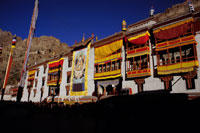 Ladakh by king Singee Namgyal. The king offered him religious estates and attended him as his principal guru.Hemis Tsechu (festival) assemble annually from 9th to 11th day of the 5th Tibetan month. The Gompa has well preserved Thankas and copper gilt statue of the lord Buddha, various stupas made of gold and silver and many auspicious objects. The largest thanka in Ladakh over 12 Mtrs. Long is at Hemis.
Ladakh by king Singee Namgyal. The king offered him religious estates and attended him as his principal guru.Hemis Tsechu (festival) assemble annually from 9th to 11th day of the 5th Tibetan month. The Gompa has well preserved Thankas and copper gilt statue of the lord Buddha, various stupas made of gold and silver and many auspicious objects. The largest thanka in Ladakh over 12 Mtrs. Long is at Hemis.
Sangam
Sangam means Confluence (where two rivers meet each other). 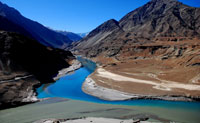
Zanskar is the river formed from the junction of two streams, Lungnak means "dark gorge" and Stod, which carries the meltwater of the great Drang-drung glacier.
At Nimo Zanskar joins Indus which ultimately called Indus. In this picture the river coming from the left is Indus, which is very clear, and forms the fertile Indus valley (Leh, Saspol, Basgo, Alchi etc) and the one on the right is the muddy Zanskar, which water is not very much useful for
the cultivation purpose.
Lamayuru:
The oldest and spectacularly set Lamayuru monastery is about 125 kms.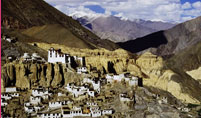 West of Leh, founded in the 10th century in 11th century the Mahasiddha Naropa came to this place. Then Rinchen Zangpo translator came and built many temples and stupas and then teaching of the Kadampa school came to flourish. Later Jamyang Namgyal offered it to Chosje Danma and Digung Kargyut school were introduced and named Yungdrung Therpalling. The Yundrung Kabgyad festival is held on the 28th and 29th days of the 2nd Tibetan month.
West of Leh, founded in the 10th century in 11th century the Mahasiddha Naropa came to this place. Then Rinchen Zangpo translator came and built many temples and stupas and then teaching of the Kadampa school came to flourish. Later Jamyang Namgyal offered it to Chosje Danma and Digung Kargyut school were introduced and named Yungdrung Therpalling. The Yundrung Kabgyad festival is held on the 28th and 29th days of the 2nd Tibetan month.
Magnetic Hill:
Located on the Leh-Kargil-Batalik national highway, and bordered by the sindhu river, the magnetic hill is a gravity hill.